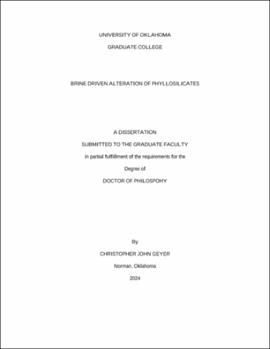| dc.description.abstract | The sedimentary structures and mineralogy of the Martian surface record a complex and inconsistently active hydrosphere throughout the planet’s history (Bibring et al., 2006; Elwood Madden et al., 2009). Phyllosilicates in particular are useful for interpreting the influence water has had on the planet, and have been detected using remote sensing, as well as ground-based lander and rover analyses (Bishop, 2018; Bishop et al., 2008). On Earth, phyllosilicates have been studied extensively, not only because of their economic value, but also because they are a product of the fluids they formed in as well as the fluids they have been subsequently exposed to (Ayari et al., 2007; Kerr, 1952; McKinley et al., 1999).
The fluid chemistry of the Martian hydrosphere likely differed from Earth’s significantly, thus, interpretations of aqueous alteration derived from common terrestrial analogues may not fully reflect aqueous alteration on Mars. In the geologic past, Mars likely had a wetter (and possibly warmer) climate which transitioned into a present-day cold and dry climate (Carter et al., 2015). As water became increasingly restricted, fluids would have become increasingly briny. This desiccation would have led to temporally and spatially variable fluid chemistries, multiple aqueous alteration mechanisms, and therefore multiple pathways for alteration of phyllosilicates (Bristow et al., 2021).
This dissertation examines aqueous processes which may have influenced and/or continues to influence phyllosilicates on Mars. Through a series of investigations, techniques including X-ray diffraction (XRD), Environmental Scanning Electron Microscopy (ESEM), Raman spectroscopy and elemental fluid composition via Inductively Coupled Plasma – Optical Emission Spectrometry (ICP-OES) are used to determine the effects of brine exposure to kaolinite (Al2Si2O5(OH)4), nontronite (Na0.4FeIII2(Si3.6Al0.4)O10(OH)2), and montmorillonite (Na0.4(Al1.6Mg0.4)Si4O10(OH)2) (Essington, 2015).
Chapter 1 details two sets of experiments which were conducted to investigate how rock-fluid interactions on Mars could have facilitated precipitation of Ca-sulfate phases such as gypsum. It was found that brine concentration as well as the specific cation/anion pairing influenced cation exchange by montmorillonite. Chapter 1 has been published in The Planetary Science Journal (Geyer et al., 2023). In Chapter 2, ESEM was used to observe cation exchange facilitated by the deliquescence of a salt. A sample of montmorillonite mixed with a Na2SO4 or MgSO4 salt underwent a cycle where relative humidity was increased from 3% to 100% and back to 3%. During this relative humidity cycle, in the absence of liquid water, the salt deliquesced and exchanged Na+ or Mg2+ with the montmorillonite. As cation exchange occurred, the Ca2+ originally in the montmorillonite grain migrated out of the grain and formed new gypsum crystals. Chapter 2 has been submitted for publication in Clays and Clay Minerals and is currently under review. Chapter 3 investigated potential aqueous alteration of kaolinite by twelve brines at 25°C and 100°. It was found that an interdependent relationship exists between temperature and brine concentration which significantly influenced kaolinite alteration, specifically, the preferential Al release from the kaolinite. Finally, Chapter 4 details a similar set of experiments to those in Chapter 3, except the clays reacted were montmorillonite and nontronite. Here it was found that both illite formation during dissolution as well as preferential release of different elements by montmorillonite and nontronite was significantly influenced by temperature-brine dependent smectite alteration pathways. | en_US |

